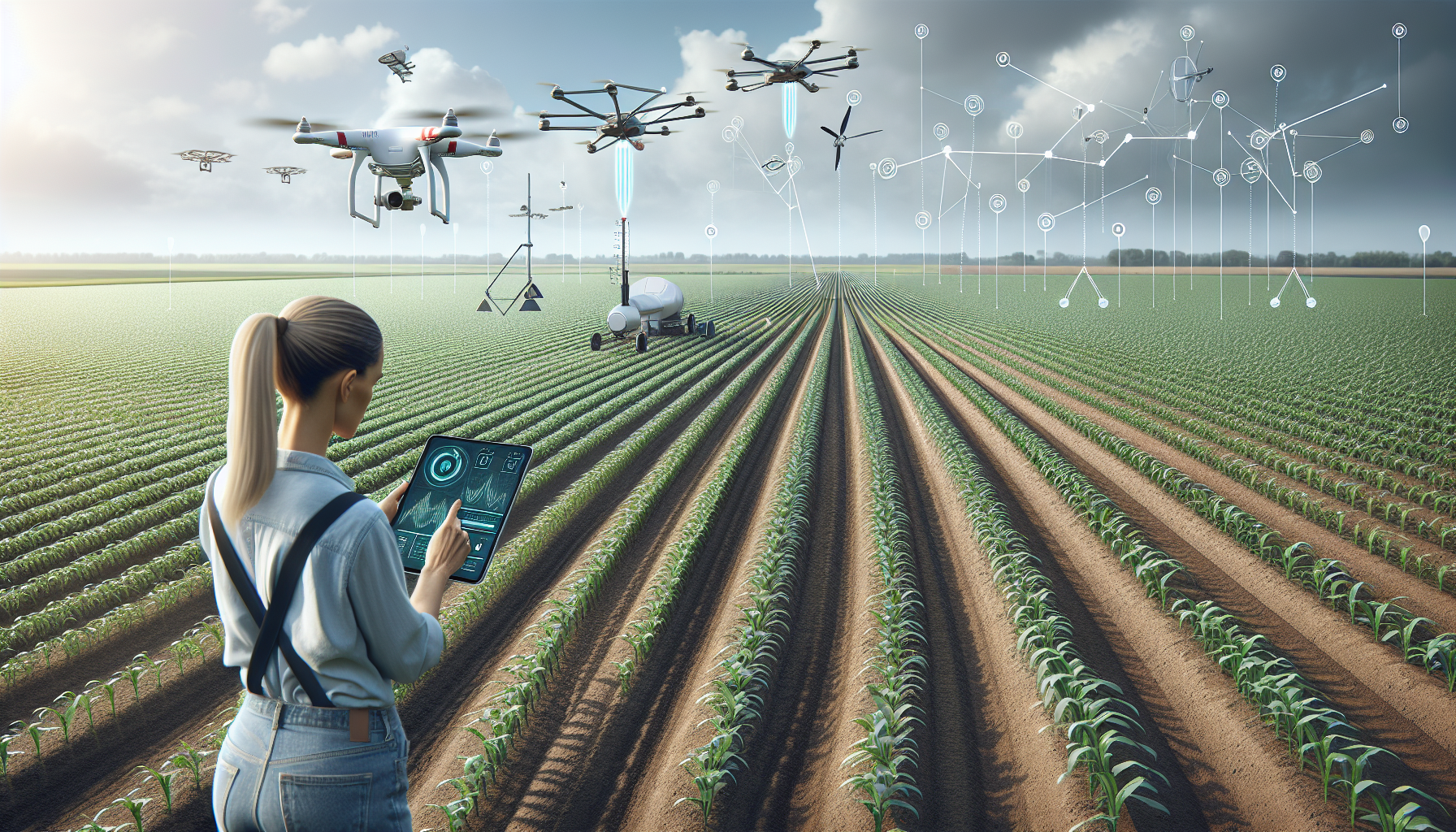In the intricate dance of modern agriculture, timing isn’t just everything—it’s the only thing. 🌱 As the global population soars and climate patterns become increasingly unpredictable, the agricultural industry faces an imperative: to produce more, with less, and faster than ever before. Enter precision agriculture—a revolution that marries advanced technology with time-honored farming practices to usher in an era of unprecedented efficiency and sustainability. At the heart of this revolution is the concept of alignments—strategic synchronizations across various agricultural processes that can dramatically enhance productivity and growth. This article will delve into the transformative power of these alignments and how they can be harnessed to optimize the timing of agricultural activities, ensuring that every seed sown and every drop of water used contributes to the greater yield.
Imagine a world where farmers can predict the exact moment to plant a seed, the precise day to irrigate, and the optimal time to harvest—maximizing growth while minimizing waste. This is not the stuff of science fiction, but the tangible promise of precision agriculture. By aligning data from weather patterns, soil conditions, and crop growth stages, farmers can make informed decisions that lead to higher yields and lower costs. However, achieving this level of precision requires a deep understanding of both the science and art of farming—a challenge that is as rewarding as it is complex. This article will explore the critical role of data analytics, machine learning, and IoT devices in creating these alignments and the ways they empower farmers to make decisions with pinpoint accuracy.
Yet, the journey towards precision is not without its challenges. The integration of new technologies into traditional farming practices requires a cultural shift and a willingness to embrace change. Additionally, the initial investment in technology can be daunting for small-scale farmers who are often the backbone of the agricultural industry. However, the potential rewards are too significant to ignore. From reducing resource waste to increasing crop resilience against climate variability, the benefits of precision agriculture alignments are multifaceted. This article will provide an in-depth analysis of these challenges and opportunities, highlighting case studies and real-world examples of farmers who have successfully navigated this transition.
As we peel back the layers of precision agricultural timing, we will uncover not only the technicalities involved but also the human stories driving this movement. By the end of this journey, you will have a comprehensive understanding of how aligning various elements in agriculture can lead to maximized growth and sustainability. Whether you are a seasoned farmer, an agribusiness investor, or simply someone interested in the future of food production, this article will equip you with valuable insights into the power of precision. Join us as we explore the intersection of technology and tradition, and discover how the alignment of timing can transform the agricultural landscape for generations to come. 🌾
The Significance of Alignments in Precision Agriculture
Precision agriculture has revolutionized the way farmers manage their crops, allowing for more efficient use of resources and maximized yields. Central to this revolution is the concept of timing. Properly timed agricultural practices can make the difference between a bountiful harvest and a disappointing yield. Alignments in precision agriculture refer to the synchronization of farming activities with optimal environmental and biological conditions. By leveraging technological advancements, farmers can now precisely time their planting, watering, fertilization, and harvesting to coincide with ideal conditions, thereby maximizing growth and productivity.
One of the key components of alignment in precision agriculture is the use of data analytics and predictive modeling. Farmers can now access real-time data on weather patterns, soil moisture levels, and crop health through advanced sensors and drones. This data allows for precise alignment of agricultural activities, ensuring that each task is performed at the most opportune time. For example, planting seeds just before a predicted rainfall can ensure optimal soil moisture for germination, while applying fertilizer during a growth spurt can enhance nutrient uptake.
Another important aspect is the alignment of crop cycles with natural pest and disease cycles. By understanding when pests are most active, farmers can time their pest control measures more effectively, reducing the need for chemical interventions and promoting sustainable farming practices. This not only leads to healthier crops but also benefits the environment by minimizing the use of harmful pesticides.
Technological Tools for Achieving Precision Alignment
In the realm of precision agriculture, technology plays a crucial role in achieving alignment. One of the most transformative tools is GPS technology, which allows for precise mapping and navigation of farmland. With GPS, farmers can implement variable rate technology (VRT), which adjusts the application of seeds, fertilizers, and pesticides based on specific field conditions. This precision ensures that resources are used efficiently and effectively, reducing waste and optimizing plant growth.
Another technological advancement aiding in precision alignment is remote sensing. Through the use of satellite imagery and aerial drones, farmers can monitor crop health and soil conditions from a bird’s eye view. This technology provides valuable insights into areas of the field that may require more attention, such as regions experiencing water stress or nutrient deficiencies. By aligning interventions with these insights, farmers can address issues proactively and ensure uniform crop development.
To further enhance precision alignment, machine learning algorithms are being developed to analyze complex datasets and predict optimal timing for agricultural activities. These algorithms consider multiple variables, such as weather forecasts, historical crop performance, and current field conditions, to generate actionable recommendations. This level of precision not only boosts productivity but also allows for more sustainable farming practices by reducing resource consumption.
Table: Comparison of Precision Agriculture Technologies
| Technology | Function | Benefits |
|---|---|---|
| GPS Technology | Field mapping and navigation | Accurate resource application, reduced waste |
| Remote Sensing | Crop health monitoring | Proactive issue identification, uniform growth |
| Machine Learning | Data analysis and prediction | Optimized timing, enhanced sustainability |
Explore the video below for a deeper understanding of these technologies in action:
The Role of Environmental and Biological Cycles
Understanding and aligning with environmental and biological cycles is fundamental in precision agriculture. Seasonal changes, such as temperature fluctuations and day length variations, significantly impact plant growth. By aligning agricultural practices with these natural cycles, farmers can optimize growth stages and enhance yields. For example, certain crops thrive when planted during specific phases of the moon, as the gravitational pull affects water retention in the soil.
Moreover, aligning with the life cycles of beneficial organisms, such as pollinators and soil microbes, can further boost agricultural productivity. Encouraging these organisms through habitat creation and reduced chemical use can enhance pollination rates and soil fertility. This symbiotic relationship emphasizes the importance of a holistic approach to precision agriculture, where every element of the ecosystem is considered and aligned for maximum benefit.
Furthermore, the alignment with biological cycles extends to understanding crop phenology. Phenology, the study of plant and animal life cycle events, provides insights into the best times for planting and harvesting. By tracking phenological stages, such as flowering and fruiting, farmers can synchronize their activities to maximize yield and quality. This alignment also aids in predicting and mitigating the impacts of climate change, as shifts in phenological patterns are often early indicators of environmental changes.
- Consider the impact of seasonal changes on crop growth.
- Encourage beneficial organisms for natural ecosystem balance.
- Utilize phenological data for informed decision-making.
Challenges and Opportunities in Precision Alignment
While the potential of precision alignment in agriculture is immense, there are challenges that need to be addressed. One of the primary obstacles is the accessibility of technology. Small-scale farmers, particularly in developing regions, may lack the resources or knowledge to implement advanced technologies. Bridging this gap requires targeted interventions, such as education programs and affordable technology solutions, to ensure that all farmers can benefit from precision agriculture.
Another challenge lies in data management. The vast amount of data generated by precision agriculture tools can be overwhelming, and without proper analysis and interpretation, this data is of little use. Developing robust data management systems and training farmers in data literacy are crucial steps in overcoming this barrier. Furthermore, concerns regarding data privacy and security must be addressed to build trust and encourage widespread adoption of precision technologies.
Despite these challenges, the opportunities presented by precision alignment are vast. As technology continues to evolve, new solutions are constantly being developed to enhance precision and efficiency. The integration of artificial intelligence and machine learning into agricultural practices holds promise for even greater advancements, enabling farmers to make more informed decisions and optimize their operations.
In conclusion, the power of alignments in precision agricultural timing cannot be overstated. By leveraging technological advancements and aligning agricultural practices with environmental and biological cycles, farmers can maximize growth, enhance sustainability, and secure food production for future generations. The journey towards precision alignment is ongoing, but with continued innovation and collaboration, the potential for transformation is limitless.

Conclusion
Certainly! Here’s a conclusion for the article titled “Maximizing Growth: The Power of Alignments for Precision Agricultural Timing.”
—
In conclusion, the exploration of maximizing growth through precise agricultural timing underscores a pivotal shift in modern farming practices. As we have navigated through this article, several key points emerged, underscoring the transformative potential of integrating alignment strategies in agriculture.
Firstly, the discussion highlighted the fundamental role of precision timing in optimizing crop yield. By aligning planting schedules with climate patterns and soil conditions, farmers can significantly enhance productivity. This approach not only boosts yields but also contributes to resource conservation, ensuring sustainable farming practices for future generations.
Secondly, the integration of technology was identified as a cornerstone of this transformation. Tools such as satellite imagery, IoT devices, and data analytics have empowered farmers with actionable insights, facilitating informed decision-making. These technologies allow for real-time monitoring and precise interventions, ultimately leading to more efficient resource utilization and reduced environmental impact.
Additionally, the article delved into the economic implications of adopting precision agricultural timing. By minimizing waste and maximizing efficiency, farmers can achieve greater profitability. This not only strengthens the agricultural sector but also supports the broader economy by stabilizing food prices and ensuring food security.
Moreover, the importance of collaboration was emphasized. Alignments in agricultural timing require a concerted effort from various stakeholders, including farmers, researchers, and policymakers. By fostering a collaborative environment, we can drive innovation and create resilient agricultural systems capable of withstanding the challenges posed by climate change and population growth.
The significance of education and training also emerged as a critical component. Equipping farmers with the necessary skills and knowledge to leverage precision timing techniques is paramount. Educational initiatives and training programs can empower farmers to adopt these innovative practices, paving the way for widespread implementation and success.
As we reflect on these insights, it becomes evident that the power of alignments in precision agricultural timing is not merely a theoretical concept but a practical solution with tangible benefits. By embracing these strategies, we can contribute to a more sustainable, efficient, and resilient agricultural future.
We encourage you, our readers, to actively engage with this vital topic. Whether you are a farmer, researcher, policymaker, or simply someone interested in the future of agriculture, your voice matters. Share your thoughts, experiences, and questions in the comments section below. Let us foster a community of knowledge-sharing and collaboration, driving forward the advancements in agricultural practices.
Additionally, we invite you to share this article with your network. By spreading awareness and fostering dialogue, we can collectively work towards a brighter future for agriculture. The challenges we face require innovative solutions, and your participation can make a difference.
Finally, consider how you can apply the insights gained from this article to your own work or community. Whether it’s adopting a new technology, participating in a local agricultural initiative, or simply staying informed, every action counts. Together, we can maximize growth, not just in our fields, but in our understanding and application of precision agricultural timing.
For further reading and resources, explore these active links:
– FAO: The Future of Food and Agriculture
– Precision Agriculture Journal
Thank you for joining us on this journey. Let’s continue to inspire and innovate, cultivating a future where agriculture thrives sustainably. 🌱🌾
—
This conclusion provides a comprehensive summary, reinforcing the importance of the topic and encouraging reader engagement and application of the discussed concepts.
Toni Santos is a visual storyteller and cosmic interpreter whose work illuminates the ancient skywatchers and their prehistoric astronomy—the profound ways early humans observed and revered the heavens before written history. Through a visionary lens, Toni explores how the stars, planets, and celestial cycles shaped myth, ritual, and survival in cultures lost to time.
Rooted in a fascination with archaic observatories, stone alignments, and celestial symbolism, Toni’s creative journey reveals the deep human impulse to understand and harmonize with the cosmos. From lunar phases guiding planting seasons to the sacred paths of the Milky Way, each of his works embodies the awe and knowledge encoded in the night sky.
Combining artistic craftsmanship with archaeological insight, Toni’s pieces evoke the mystery and precision of prehistoric astronomers. His work does more than depict—it channels the timeless dance between earth and sky, bridging ancient wisdom with contemporary wonder.
As the visionary behind Vizovex, Toni shares curated visuals, essays, and symbolic studies that invite others to reconnect with the cosmic heritage written in stone and starlight. His creations are a call to look upward, to listen to the silent stories told by the stars, and to honor the first astronomers who mapped the heavens with reverence and ingenuity.
His work is a tribute to:
The celestial wisdom of prehistoric peoples
The sacred geometry of ancient observatories
The enduring bond between human culture and the cosmos
Whether you’re a stargazer, a scholar of ancient mysteries, or someone captivated by the universe’s earliest storytellers, Toni welcomes you to journey through a space where the sky is both map and myth—one constellation, one ritual, one revelation at a time.




